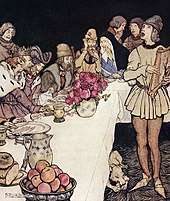Dinadan
Sir Dinadan (Dinadam, Dinadano, Dinadeira, Divdan, Dynadan) is a Knight of the Round Table in the Arthurian legend's chivalric romance tradition. He is the son of Brunor senior (the Good Knight without Fear), a brother of Breunor le Noir and Daniel, and a close friend of Tristan.

In medieval literature

Alike Palamedes and Lamorak, Dinadan was an invention of the Prose Tristan, and appeared in later retellings including the Post-Vulgate Cycle and Thomas Malory's Le Morte d'Arthur. Unlike most other knights in Arthurian romance, Dinadan prefers to avoid fights and considers courtly love a waste of time, though he is a brave fighter when he needs to be. In Le Morte d'Arthur (Book 10, chapter 56), he is visiting the court of Cornwall seeking his friend Tristan, and has supper with Queen La Beale Isoud where he reveals that he has (by his own desire) no lady-love or paramour in whose name to do great deeds.

Dinadan is known for his cynical humor and joking nature, and for his mockery of chivalry.[1] He is more sociable than most of the knights, and is often a useful companion because of it. He is also nearly always portrayed as the wittiest of all of Arthur's knights, and a source and target of practical jokes. In Le Morte d'Arthur, he is one of the few knights to be able to recognise his fellows from their faces in addition to their shields; in one instance Tristan does not recognise his own King until Dinadan tells him who it is. In one notable exploit, he writes an insulting ballad about King Mark and sends a troubador to play it at Mark's court. In another episode, he loses a joust when Lancelot catches him off guard by wearing a dress over his armour; Lancelot then puts the dress on his unconscious opponent.
In the Italian Tavola Ritonda, Dinadan (Dinadano) attempts to kill Mark in revenge for the death of Tristan. In Le Morte d'Arthur, following the Prose Tristan narrative, Dinadan dies when he returns from Cornwall, hoping to persuade King Arthur to reverse his ruling which had again set Mark on the throne. However Dinadan, still wounded from his fight with Brehu the Merciless, is treacherously ambushed and murdered by his fellow Round Table knights Mordred and Agravain, who hated him due to his closeness to their enemy Lamorak. Hector finds him mortally wounded and takes him to Camelot, where he dies in Lancelot's arms.
In modern fiction
Dinadan's modern appearances included the stage version and film adaptation of the musical Camelot, portrayed by John Cullum, Christopher Sieber, and (in the film) Anthony Rogers. He is protagonist of Gerald Morris' 2003 novel The Ballad of Sir Dinadan[2] as well as subject of the chapter "Sir Dinadan the Humorist" in Mark Twain's 1890 A Connecticut Yankee in King Arthur's Court.[3]
See also
- Dagonet, King Arthur's court jester
References
- Rovang, Paul (2014). Malory's Anatomy of Chivalry: Characterization in the Morte Darthur. Rowman & Littlefield. ISBN 9781611477795.
- Morris, Gerald (2008). The Ballad of Sir Dinadan. Houghton Mifflin Harcourt. ISBN 9780547349848.
- "Chapter 4: "Sir Dinadan the Humorist" | A Connecticut Yankee In King Arthur's Court | Mark Twain". etc.usf.edu. Retrieved 21 February 2019.